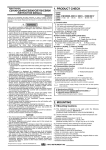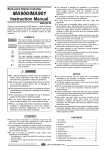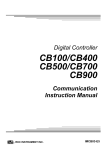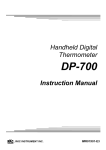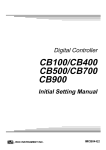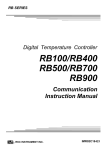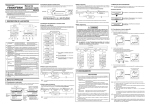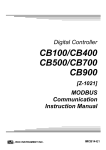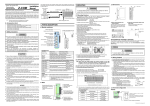Download ZL electronics Technology 900C Instruction manual
Transcript
Digital Controller REX-C100/C400/C410/C700/C900 1. PRODUCT CHECK INSTRUCTION MANUAL C100 (1) (2) (3) IMNZC21-E1 Thank you for purchasing the RKC instrument. In order to achieve maximum performance and ensure proper operation of your new instrument, carefully read all the instructions in this manual. Please place this manual in a convenient location for easy reference. NOTICE • This manual assumes that the reader has a fundamental knowledge of the principles of electricity, process control, computer technology and communications. • The figures, diagrams and numeric values used in this manual are only for purpose of illustration. • RKC is not responsible for any damage or injury that is caused as a result of using this instrument, instrument failure or indirect damage. • Periodic maintenance is required for safe and proper operation of this instrument. Some components have a limited service life, or characteristics that change over time. • Every effort has been made to ensure accuracy of all information contained herein. RKC makes no warranty expressed or implied, with respect to the accuracy of the information. The information in this manual is subject to change without prior notice. • No portion of this document may be reprinted, modified, copied, transmitted, digitized, stored, processed or retrieved through any mechanical, electronic, optical or other means without prior written approval from RKC. All Rights Reserved, Copyright 2004, RKC INSTRUMENT INC. ® * (6)(7) * (6) (7) F: PID action with autotuning (Reverse action) D: PID action with autotuning (Direct action) W: Heat/cool PID action with autotuning (Water cooling) 1 A : Heat/cool PID action with autotuning (Air cooling) 1 (2) Input type, (3) Range code See “9. INPUT RANGE TABLE.” (4) First control output [OUT1] (Heat-side) M: Relay contact 8: Current (4 to 20 mA DC) V: Voltage pulse G: Trigger (for triac driving) 2 (5) Second control output [OUT2] (Cool-side) 3 No symbol: When control action is F or D. M: Relay contact V: Voltage pulse 8: Current (4 to 20 mA DC) (6) Alarm 1 [ALM1], (7) Alarm 2 [ALM2] N: A: B: C: D: E: No alarm Deviation high alarm Deviation low alarm Deviation high/low alarm Band alarm Deviation high alarm with hold action F: Deviation low alarm with hold action G: Deviation high/low alarm CAUTION • This is a Class A instrument. In a domestic environment, this instrument may cause radio interference, in which case the user may be required to take adequate measures. • This instrument is protected from electric shock by reinforced insulation. Provide reinforced insulation between the wire for the input signal and the wires for instrument power supply, source of power and loads. • Be sure to provide an appropriate surge control circuit respectively for the following: - If input/output or signal lines within the building are longer than 30 meters. - If input/output or signal lines leave the building, regardless the length. • This instrument is designed for installation in an enclosed instrumentation panel. All high-voltage connections such as power supply terminals must be enclosed in the instrumentation panel to avoid electric shock by operating personnel. • All precautions described in this manual should be taken to avoid damage to the instrument or equipment. • All wiring must be in accordance with local codes and regulations. • All wiring must be completed before power is turned on to prevent electric shock, instrument failure, or incorrect action. The power must be turned off before repairing work for input break and output failure including replacement of sensor, contactor or SSR, and all wiring must be completed before power is turned on again. • To prevent instrument damage of failure, protect the power line and the input/output lines from high currents with a protection device such as fuse, circuit breaker, etc. • Prevent metal fragments or lead wire scraps from falling inside instrument case to avoid electric shock, fire or malfunction. • Tighten each terminal screw to the specified torque found in the manual to avoid electric shock, fire or malfunction. • For proper operation of this instrument, provide adequate ventilation for heat dispensation. • Do not connect wires to unused terminals as this will interfere with proper operation of the instrument. • Turn off the power supply before cleaning the instrument. • Do not use a volatile solvent such as paint thinner to clean the instrument. Deformation or discoloration will occur. Use a soft, dry cloth to remove stains from the instrument. • To avoid damage to instrument display, do not rub with an abrasive material or push front panel with a hard object. • Do not connect modular connectors to telephone line. (4) C400 C410 C700 C900 (1) (2) (3) (4) (5) (1) Control action WARNING • An external protection device must be installed if failure of this instrument could result in damage to the instrument, equipment or injury to personnel. • All wiring must be completed before power is turned on to prevent electric shock, fire or damage to instrument and equipment. • This instrument must be used in accordance with the specifications to prevent fire or damage to instrument and equipment. • This instrument is not intended for use in locations subject to flammable or explosive gases. • Do not touch high-voltage connections such as power supply terminals, etc. to avoid electric shock. • RKC is not responsible if this instrument is repaired, modified or disassembled by other than factory-approved personnel. Malfunction can occur and warranty is void under these conditions. - H: J: K: L: P: S: R: Process high alarm Process low alarm Process high alarm with hold action Process low alarm with hold action Heater break alarm (CTL-6) 4 Heater break alarm (CTL-12) 4 Control loop break alarm 5 with hold action 1 C100 cannot be specified in Heat/cool PID action. 2 For the C100, when control output is trigger output for triac driving, only the ALM1 is available. 3 For the C100, there is no second control output. 4 Heater break alarm cannot be specified in case of ALM1. Also, it isn’t possible to specify when control output is current output. 5 As control loop break alarm, only either the ALM1 or ALM2 is selected. Check that power supply voltage is also the same as that specified when ordering. <Accessories> Mounting brackets (C100/C400/C410/C700/C900): 2 Instruction manual (IMNZC21-E1): 1 2. MOUNTING 2.1 Mounting Cautions (1) This instrument is intended to be used under the following environmental conditions. (IEC61010-1) [OVERVOLTAGE CATEGORY II, POLLUTION DEGREE 2] (2) Use this instrument within the following ambient temperature and ambient humidity. • Allowable ambient temperature: 0 to 50 °C • Allowable ambient humidity: 45 to 85 % RH (3) Avoid the following when selecting the mounting location. • Rapid changes in ambient temperature which may cause condensation. • Corrosive or inflammable gases. • Direct vibration or shock to the mainframe. • Water, oil, chemicals, vapor or steam splashes. • Excessive dust, salt or iron particles. • Excessive induction noise, static electricity, magnetic fields or noise. • Direct air flow from an air conditioner. • Exposure to direct sunlight. • Excessive heat accumulation. RKC INSTRUMENT INC. 2.2 Dimensions C100 2.3 Mounting procedures 8 When the controllers are mounted on panel with 1 to 5 mm in thickness 44 (Unit: mm) 48 Since the mounting brackets are already installed on the controller, insert the controller into the panel front without removal of the brackets. + 0.6 0 + 0.6 45 0 When the controllers are mounted on panel with 5 to 9 mm in thickness 25 45 44 (53) 25 48 Mounting bracket C100 100 43 C400 Mounting bracket Remove the mounting brackets from the controller with a slotted screwdriver. Engage each mounting bracket with holes marked with 5-9 on the housing and then insert the controller into the panel from the panel front. Hole for 5 to 9 mm Hole for 1 to 5 mm (Unit: mm) 12 48 100 25 45 C400/C410/C700/C900 +0.6 0 +0.8 0 92 2. 3. 30 91 100 96 1. C410 12 4. 100 5. 91 100 (Unit: mm) 96 C900 is used in the above figures for explanation, but the same mounting procedures also apply to C400/C410/C700. 92 +0.8 0 3. WIRING 25 45 43 +0.6 0 30 48 Prepare the panel cutout as specified in 2.2 Dimensions. Bracket Insert the instrument through Insertion setscrew recess the panel cutout. Insert an upper mounting bracket along the bracket insertion groove from the back, and then engage a projection at the bracket end with Bracket insertion a recess at the groove front and groove Slot also insert metal fitting legs into slots. Tighten a bracket setscrew from the rear of the bracket with Phillips screwdriver. Do not overtighten the bracket setscrew. The other mounting bracket should be installed the same way described in 3. and 4. ! WARNING To prevent electric shock or instrument failure, do not turn on the power until all the wiring is completed. C700 67.6 (Unit: mm) 25 68 +0.7 0 +0.7 0 100 68 30 72 67.6 77 12 72 3.1 Wiring Cautions C900 Instrument power 91 (Unit: mm) • For thermocouple input, use the appropriate compensation wire. • For RTD input, use low resistance lead wire with no difference in resistance between the three lead wires. • To avoid noise induction, keep input signal wire away from instrument power line, load lines and power lines of other electric equipment. • If there is electrical noise in the vicinity of the instrument that could affect operation, use a noise filter. - Shorten the distance between the twisted power supply wire pitches to achieve the most effective noise reduction. - Always install the noise filter on a grounded panel. Minimize the wiring distance between the noise filter output and the instrument power supply terminals to achieve the most effective noise reduction. - Do not connect fuses or switches to the noise filter output wiring as this will reduce the effectiveness of the noise filter. Twist these liadwires IN +0.8 0 92 25 100 30 12 91 (100) 96 96 Shorten distance between pitches +0.8 92 0 Panel thickness: 1 to 5 mm or 5 to 9 mm (C100) 1 to 8 mm (C400/C410/C700/C900) 2 Noise filter OUT Minimize distance Instrument Power terminals • Power supply wiring must be twisted and have a low voltage drop. • About 5 to 6 seconds are required as preparation time for contact output every time the instrument is turned on. Use a delay relay when the output line, is used for an external interlock circuit. • This instrument is not furnished with a power supply switch or fuses. Therefore, if a fuse or power supply switch is required, install close to the instrument. - Fuse type: Time-lag fuse - Recommended fuse rating: Rated voltage 250 V Rated current: 1 A • For an instrument with 24 V power supply, supply power from a SELV circuit. IMNZC21-E1 3.2 Terminal Configuration C100 Alarm output Relay contact Power supply 1 Alarm 1 or Control loop break alarm 1 ALM1 Alarm 2, Heater break alarm or Control loop break alarm 2 NO ALM2 3 NO Control output Trigger for triac drive OUT T1 + 4 5 − 7 3 8 4 9 5 11 12 10 11 5 5 L 6 7 + DC 100−240V 7 N AC L 6 24V 24V 7 − N • Terminals which are not used according to the controller type are all removed. • When control output is trigger output for triac driving, the number of alarm output points becomes 1. • Use the solderless terminal appropriate to the screw size. Screw size: M3 x 6 Recommended tightening torque: 0.4 N m [4 kgf cm] Maximum allowance: 0.7 N m [7 kgf cm] Input Current transformer 4 AC 6 TC input 8 RTD input + 8 12 A Voltage/Current + 8 RTD TC 9 − NO OUT G 2 OUT 4 6 CT input Voltage pulse/ Relay contact Current 3 T2 13 14 CT 9 B 10 B 9 − 6.2 mm (0.24 inch) or less NO: Normally open C400, C410, C900 Ground 1 Power supply AC L + DC 2 24V 24V N 3 − 3 Voltage pulse/ Relay contact Current 6 T1 + 7 OUT 7 7 8 N − 8 F, D action types NC 5 3 − 6 + 7 OUT1 L + DC 2 15 7 2 N 3 OUT T1 + 7 OUT G 8 7 + 7 OUT 7 − 8 F, D action types NC 8 16 A 15 − 16 + 15 10 4 CT input 17 11 5 18 Current transformer input 6 19 12 7 20 13 L AC 2 接点 3 N 5 6 7 8 − 8 W, A action types Relay contact 8 TC input 12 − RTD input 11 B 12 B RTD 13 A TC 13 + 9 10 20 13 + Relay contact output: 250 V AC, 1A (Resistive load) Electrical life: 50,000 times or more (Rated load) Heater break alarm function: Measured current: 0 to 30 A (CTL-6-P-N) 0 to 100 A (CTL-12-S56-10L-N) Input rating: Maximum current rating: 120 mA Input impedance: Approx. 2.5 Ω ON/OFF, P, PI, or PD actions is available Display accuracy (at the ambient temperature 23 °C ± 2 °C): Control output: Thermocouple: Relay contact output: 250 V AC, 3A (Resistive load) ± (0.5 % of display value + 1 digit) or ± 3 °C [6 °F] Electrical life: Whichever is greater 300,000 times or more (Rated load) R and S input: 0 to 399 °C [0 to 799 °F]: Voltage pulse output: 0/12 V DC ± 6 °C [12 °F] (Load resistance 600 Ω or more) B input: 0 to 399 °C [0 to 799 °F]: Current output: 4 to 20 mA DC Accuracy is not guaranteed. (Load resistance 600 Ω or less) Trigger output (for triac driving): RTD: ± (0.5 % of display value + 1 digit) Zero cross method for medium capacity or ± 0.8 °C [1.6 °F] triac driving (100 A or less) whichever is greater Load voltage used: Voltage/Current: ± (0.5 % of span + 1 digit) 100 V AC line, 200 V AC line Load used: Resistive load IMNZC21-E1 NO Screw size: M3 x 6 Terminals Nos. 1 to 10 (Power terminals, Alarm terminals and Output terminals) Alarm output: Performance: Alarm 2, Heater break alarm or Control loop break alarm • Terminals which are not used according to the controller type are all removed. • Use the solderless terminal appropriate to the screw size. Recommended tightening torque: 0.4 N m [4 kgf cm] Maximum allowance: 1.0 N m [10 kgf cm] Voltage/Current − NO ALM2 CT 12 Alarm 1 or Control loop break alarm ALM1 19 Input OUT1 NO NO Alarm output 16 Input type: Thermocouple: K, J, R, S, B, E, T, N, PLII, W5Re/W26Re, U, L Input impedance: Approx. 1 MΩ RTD: Pt100, JPt100 Voltage: 0 to 5 V DC, 1 to 5 V DC Input impedance: 250 kΩ or more Current: 0 to 20 mA DC, 4 to 20 mA DC Input impedance: Approx. 250 Ω Sampling cycle: 0.5 seconds See Input range table Input range: Control method: PID control B RTD Voltage/Current 3 Specifications Input: 15 Alarm 2, Heater break alarm or Control loop break alarm • Terminals which are not used according to the controller type are all removed. • An example of the C900 is described here, the same wiring examples also apply to C400/C410. (Terminal numbers 17 to 24 are not provided for C400/C410.) • Use the solderless terminal appropriate to the screw size. Screw size: M3 x 8 Recommended tightening torque: 0.4 N m [4 kgf cm] Maximum allowance: 1.0 N m [10 kgf cm] Power supply OUT1 NO 11 13 9 NO 6 CT 8 5 − B NO ALM2 14 OUT2 6 14 10 12 2 Control output 6 T2 14 15 16 Alarm 1 or Control loop break alarm ALM1 8.1 mm (0.32 inch) or less Voltage pulse/ Relay contact Current OUT2 Voltage pulse/ Relay contact Current − 16 + 100−240V + Trigger for triac drive 9 Current transformer input 1 − 3 NO: Normally open NC: Normally closed Relay contact CT input 12 13 RTD input TC リレ 24V Alarm output 9 10 11 Ground 1 24V 21 22 23 24 NO C700 AC 5 6 7 8 TC input 6 8 − 8 W, A action types 8 17 18 19 20 Input 5 NO OUT1 NO OUT G 2 100−240V OUT2 6 OUT L Voltage pulse/ Relay contact Current OUT2 + T2 AC Control output NO: Normally open NC: Normally closed Trigger for triac drive 2 1 2 3 4 Screw size: M3 x 8 Terminals Nos. 11 to 13 (Input terminals) 6.2 mm (0.24 inch) or less 8.1 mm (0.32 inch) or less Memory backup: Backed up by Nonvolatile Memory Number of write times: Approx. 100,000 times Data storage period: Approx. 10 years Power: Power supply voltage: 85 to 264 V AC (Power supply voltage range), 50/60 Hz Rating: 100 to 240 V AC 21.6 to 26.4 V AC (Power supply voltage range), 50/60 Hz Rating: 24 V AC 21.6 to 26.4 V DC (Power supply voltage range) Rating: 24 V DC Power consumption: 6 VA max. (at 100 V AC) 9 VA max. (at 240 V AC) 6 VA max. (at 24 V AC) 145 mA max. (at 24 V DC) Weight: C100: C700: C400/C410: C900: Approx. 170 g Approx. 250 g Approx. 260 g Approx. 340 g 3 4. PARTS DESCRIPTION C100 C400 (1) ALM1 ALM2 OUT PV OUT1 (1) SV (2) AT (1) (3) PV C410 C700, C900 (3) PV PV ALM1 OUT2 ALM2 (1) AT SV SV (2) SET SET SV (2) REX-C410 REX-C100 OUT1 AT ALM1 OUT2 (3) (4) (5) (6) (7) (3) ALM2 (4) (2) (5) (6) (7) OUT2 OUT1 AT ALM1 (3) ALM2 (4) SET SET REX-C900 REX-C400 (4) (5) (6) (7) (1) Measured value (PV) display [Green] Displays PV or various parameter symbols. (2) Set value (SV) display [Orange] Displays SV or various parameter set values (or CT input value). (3) Indication lamps Alarm output lamps (ALM1, ALM2) [Red] ALM1: Lights when alarm 1 output is turned on. ALM2: Lights when alarm 2 output is turned on. (5) Autotuning (AT) lamp [Green] Flashes when autotuning is activated. (After autotuning is completed: AT lamp will become OFF) (4) SET (Set key) Used for parameter calling up and set value registration. Control output lamps (OUT1 [Yellow], OUT2 [Green]) OUT1: Lights when control output is turned on.* OUT2: Lights when cool-side control output is turned on. (5) (Shift key) Shift digits when settings are changed. (6) (7) (6) (DOWN key) Decrease numerals. (7) (UP key) Increase numerals. To avoid damage to the instrument, never use a sharp object to press keys. 5. SETTING 5.1 Operation Menu Parameter Setting Mode This mode is used to set the parameters such as alarms, PID constants, etc. (See 5.2 Parameter List.) The following parameter symbols are displayed as the SET key is pressed. Power ON Input type and Input range Display Automatically (in 4 sec.) Press the SET key for 2 seconds. PV/SV Display Mode The controller will display the measured value (PV) and the set value (SV). Current transformer (CT) input value monitor (CT) (LbA) SET key Alarm 1 set value (ALM1) (AL1) SV Setting Mode (AL2) This is the mode used to set the SV. PV SV Press the SET key for 2 seconds. SV setting Factory set value: Alarm 2 set value (ALM2) Heater break alarm (HBA) set value (HbA) 0 °C [°F] or 0.0 °C [°F] This instrument returns to the PV/SV display mode if no key operation is performed for more than one minute. SET key Deadband * (db) SET key Autotuning (AT) (ATU) (Ar) SET key SET key SET key Derivative time (D) (Lbd) (P) (Pc) SET key LBA deadband SET key Cool-side proportioning band * Integral time (I) SET key SET key Press the SET key Control loop break alarm (LBA) time Proportional band (T) SET key Anti-reset windup (t) SET key SET key Heat-side proportioning Set data lock (LCK) SET key SET key Cool-side proportioning cycle * SET key Return to the first parameter * These parameter are not displayed Parameters which are not related to existing functions on the controller are not displayed. in C100 controller. Input type and input range display This instrument immediately confirms the input type symbol and input range following power ON. Example: When sensor type of input is K thermocouple. * Input Type Symbol Table Symbol PV Automatically SV PV Input range high SV Input range low Symbol Thermocouple (TC) Input type Input type symbol * K J R S B E T N PL II Unit for input and SV display (Celsius: °C, Fahrenheit: °F, Voltage/current input: no character shown) RTD W5Re/ W26Re U L JPt 100 Pt 100 Voltage Current input input 5.2 Parameter List The following parameter symbols are displayed as the SET key is pressed. Parameter symbols which are not related to existing functions on the controller are not displayed. Symbol Name Setting range Current 0.0 to 100.0 A transformer (CT) [Display only] input value monitor Temperature input: Alarm 1 set value Deviation alarm, Process alarm: (ALM1) −1999 to +9999 °C [°F] or −199.9 to +999.9 ° C [°F] Alarm 2 set value Voltage/current inputs: (ALM2) Deviation alarm: −199.9 to +200.0 % Process alarm: −199.9 to +300.0 % 4 Description Display input value from the current transformer. [Displayed only when the instrument has the heater break alarm] Set the alarm 1 set value and alarm 2 set value. For the alarm action type, see page 7. Alarm differential gap: Temperature input: 2 or 2.0 °C [°F] Voltage/current inputs: 0.2 % of span Factory set value Temperature input: 50 (50.0) Voltage/current inputs: 5.0 IMNZC21-E1 Symbol Description Factory set value 0.0 to 100.0 A Heater break alarm (HBA) set value 1 Control loop break 0.1 to 200.0 minutes alarm (LBA) time 2 Name Setting range Alarm value is set by referring to input value from the current transformer (CT). Used only for single-phase. Set control loop break alarm set value. 0.0 LBA deadband 3 Temperature input: 0 to 9999 °C [°F] Voltage/current inputs: 0 to 100 % of span Autotuning (AT) 0: AT end or cancel 1: AT start or execution Set the area of not outputting LBA. No LBA deadband functions with 0 set. Differential gap : Temperature input: 0.8 °C [°F ] Voltage/current inputs: 0.8 % of span Turns the autotuning ON/OFF. Proportional band Temperature input: 1 (0.1) to span 0.1 °C [°F] resolution: Within 999.9 °C [°F] Voltage/current inputs: 0.1 to 100.0 % of span 0 0 Anti-reset windup (ARW) Heat-side proportioning cycle 1 to 100 % of heat-side proportional band (0 %: Integral action OFF) 1 to 100 seconds (Not displayed if the control output is current output.) Set when PI, PD or PID control is performed. Heat/cool PID action: Proportional band setting on the heat-side. ON/OFF action control when set to 0 (0.0). ON/OFF action differential gap: Temperature input: 2 (0.2) °C [°F ] Voltage/current inputs: 0.2 % of span Set the time of integral action to eliminate the offset occurring in proportional control. Set the time of derivative action to improve control stability by preparing for output changes. Overshooting and undershooting are restricted by the integral effect. Set control output cycle. Heat/cool PID action: Heat-side proportioning cycle Cool-side proportional band 1 to 1000 % of heat-side proportional band Set cool-side proportional band when heat/cool PID action. Deadband Temperature input: −10 to +10 °C [°F] or −10.0 to +10.0 °C [°F] Voltage/current inputs: −10.0 to +10.0 % of span 1 to 100 seconds (Not displayed if the control output is current output.) 0100: No set data locked (All parameters changeable) 0101: Set data locked (All parameters locked) 0110: Only the set value (SV) is changeable with the set data locked Set control action deadband between heat-side and cool-side proportional bands. Minus (−) setting results in overlap. Integral time Derivative time Cool-side proportioning cycle Set data lock (LCK) 1 to 3600 seconds (0 second: PD action) 1 to 3600 seconds (0 second: PI action) 1 Heater Break Alarm (HBA) function The HBA function monitors the current flowing through the load by a dedicated current transformer (CT), compares the measured value with the HBA set value, and detects a fault in the heating circuit. Low or No current flow (Heater break, malfunction of the control device, etc.): When the control output is ON and the current transformer input value is equal to or less than the heater break determination point for the preset number of consecutive sampling cycle, an alarm is activated. Over current or short-circuit: When the control output is OFF and the current transformer input value is equal to or greater than the heater break determination point for the preset number of consecutive sampling cycle, an alarm is activated. Precaution for HBA setting: • Displayed only for when HBA is selected as Alarm 2. • HBA is not available on a current output. • Set the set value to approximately 85 % of the maximum reading of the CT input. • Set the set value to a slightly smaller value to prevent a false alarm if the power supply may become unstable. • When more than one heater is connected in parallel, it may be necessary to increase the HBA set value to detect a single heater failure. • When the current transformer is not connected or the HBA set value is set to “0.0”, the HBA is turned on. 8.0 Temperature input: 30 (30.0) Voltage/current inputs: 3.0 240 60 100 Relay contact output: 20 Voltage pulse output/ Trigger output for triac driving: 2 100 0 or 0.0 Set control cool-side output cycle for heat/cool PID action. Relay contact output: 20 Voltage pulse output: 2 Performs set data change enable/disable. 0100 Precaution for LBA setting: • Displayed only for when LBA is selected as Alarm 1 or Alarm 2. • No control loop break alarm can be used at heat/cool PID control action. • The LBA function can not be activated when AT function is turned on. • The LBA function is activated when control output reaches 0 % or 100 %. The time required for the LBA output to turn on includes both the time from the initial occurrence of loop failure and the LBA setting time. Recommended setting for LBA is for the set value of the LBA to be twice the value of the integral time (I). • If LBA setting time does not match the controlled object requirements, the LBA selling time should be lengthened. If setting time is not correct, the LBA will malfunction by turning on or off at inappropriate times or not turning on at all. 3 LBA Deadband function The LBA may malfunction due to external disturbances. To prevent malfunctioning due to external disturbance, LBA deadband (LBD) sets a neutral zone in which LBA is not activated. When the measured value (PV) is within the LBD area, LBA will not be activated. If the LBD setting is not correct, the LBA will not work correctly. LBD differential gap* Alarm area A Non-alarm area B Alarm area Low 2 Control Loop Break Alarm (LBA) function The LBA function is used to detect a load (heater) break or a failure in the external actuator (power controller, magnet relay, etc.), or a failure in the control loop caused by an input (sensor) break. The LBA function is activated when control output reaches 0 % or 100 %. LBA monitors variation of the measured value (PV) for the length of LBA time. When the LBA time has elapsed and the PV is still within the alarm determination range, the LBA will be ON. IMNZC21-E1 High Set value (SV) A: During temperature rise: Alarm area During temperature fall: Non-alarm area B: During temperature rise: Non-alarm area * TC and RTD inputs: 0.8 °C [°F] (fixed) LBD set value B: During temperature rise: Non-alarm area During temperature fall: Alarm area Voltage/Current inputs: 0.8 % of span (fixed) 5 5.3 Changing Parameter Settings 6.3 Autotuning (AT) Function Procedures to change parameter settings are shown below. Autotuning (AT) automatically measures, calculates and sets the optimum PID and LBA constants. The following conditions are necessary to carry out autotuning and the conditions which will cause the autotuning to stop. Caution for using the Autotuning (AT) When a temperature change (UP and/or Down) is 1 ° C or less per minute during Autotuning, Autotuning may be cancelled before calculating PID values. In that case, adjust the PID values manually. It is possible to happen when the set value is around the ambient temperature or is close to the maximum temperature achieved by the load. Requirements for AT start Start the autotuning when all following conditions are satisfied: • Prior to starting the AT function, end all the parameter settings other than PID and LBA. • Confirm the LCK function has not been engaged. When the autotuning is finished, the controller will automatically returns to PID control. Requirements for AT cancellation The autotuning is canceled if any of the following conditions exist. • When the set value (SV) is changed. • When the PV bias value is changed. • When the PV becomes abnormal due to burnout. • When the power is turned off. • When power failure longer than 20 ms occurs. If the AT is canceled, the controller immediately changes to PID control. The PID values will be the same as before AT was activated. When AT is completed, the controller immediately changes to PID control. If the control system does not allow the AT cycling process, set each PID constant manually to meet the needs of the application. To store a new value for the parameter, always press the SET key. The display changes to the next parameter and the new value will be stored. − A new value will not be stored without pressing SET key after the new value is displayed on the display. − After a new value has been displayed by using the UP and DOWN keys, the SET key must be pressed within one minute, or the new value is not stored and the display will return to the PV/SV monitor screen. z Change the set value (SV) Change the set value (SV) from 0 ° C to 200 ° C 1. Select the SV setting mode Press the SET key at PV/SV monitor screen until SV setting screen is displayed. PV PV PV/SV monitor display SV (PV/SV display mode) SV SV setting display (SV setting mode) 2. Shift the high-lighted digit Press the shift key to high-light the hundreds digit. The high-lighted digit indicates which digit can be set. PV PV SV SV 3. Change the set value Press the UP key to change the number to 2. PV PV SV SV 4. Store the set value Press the SET key to store the new set value. The display returns to the PV/SV monitor screen. PV PV SV SV 7. INITIAL SETTING ! PV/SV monitor display (PV/SV display mode) 表 ド z Change parameters other than the set value (SV) The changing procedures are the same as those of example 2 to 4 in the above "z Change the set value (SV)". Pressing the SET key after the setting end shifts to the next parameter. When no parameter setting is required, return the instrument to the PV/SV display mode. 6. OPERATION CAUTIONS 7.1 Go to Initialization Mode 1. 2. 3. 4. zAll mounting and wiring must be completed before the power is turned on. If the input signal wiring is disconnected or short-circuited (RTD input only), the instrument determines that burnout has occurred. Turn on the power to this controller. The instrument goes to the PV/SV display after confirming input type symbol and input range. Press the SET key for five seconds to go to the Parameter Setting Mode from the PV/SV display. Press the SET key until “LCK” (Set Data Lock display) will be displayed. The high-lighted digit indicates which digit can be set. Press shift key to high-light the hundreds digit. (The section in each image of the controller shows the digits which are not high-lighted.) PV − Displays: Thermocouple input, RTD input (when input break) • Upscale: • Downscale: Thermocouple input (specify when ordering), RTD input (when short-circuited), Voltage input (1 to 5 V DC), Current input (4 to 20 mA DC) • For the voltage (0 to 5 V DC) or current (0 to 20 mA DC) input, the display becomes indefinite (display of about zero value). − Outputs: • Control output: OFF (Heat/Cool control: the control output on both heat-side and cool-side is turned off) • Alarm output: Both of the Alarm 1 and Alarm 2 outputs of this instrument are turned on when burnout occurs regardless of any of the following actions taken. (High alarm, low alarm, etc.) In addition, when used for any purposes other than these alarms (event, etc.), specify the Z-124 specification (not to be forcibly turned on). zA power failure of 20 ms or less will not affect the control action. When a power failure of more than 20 ms occurs, the instrument assumes that the power has been turned off. When power returns, the controller will retain the conditions that existed prior to shut down. zThe alarm hold action is activated when not only the power is turned on, but also the SV is changed. 6.1 Operating Precautions (1) All mounting and wiring must be completed before the power is turned on. (2) The settings for the SV and all parameters should be appropriate for the controlled object. (3) A power supply switch is not furnished with this instrument. It is ready to operate as soon as the power is turned on. 6.2 Set Data Lock (LCK) Function Parameters which can be changed All parameters [Factory set value] No parameters [All Locked] SV Parameters protected by Set Data Lock function are still displayed for monitoring. 6 Set data lock function display SV 5. Press the DOWN key to change 1 to 0. PV Set value 0: Initialization mode unlocked 1: Initialization mode locked SV 6. Press the SET key to store the new set value. The display goes to the next parameter, and the Initialization mode is unlocked. PV CT1 input value display SV 7. The parameter displayed varies on the instrument specification. Press the shift key for five seconds while pressing the SET key to go to the Initialization Mode. When the controller goes to the Initialization Mode, “SL1” will be displayed. CT1 input value display PV PV SV SV Initialize code selection display of initialization mode If the control is set to the initial set mode, all outputs are turned OFF. 7.2 Exit Initialization Mode When any parameter setting is changed in the Initialization Mode, check all parameter set values in SV Setting Mode and Parameter Setting Mode. 1. 2. 3. 4. The set data lock restricts parameter setting changes by key operation. This function prevents the operator from making errors during operation. Set value 0100 0101 0110 WARNING Parameters in the Initialization mode should be set according to the application before setting any parameter related to operation. Once the Parameters in the Initialization mode are set correctly, those parameters are not necessary to be changed for the same application under normal conditions. If they are changed unnecessarily, it may result in malfunction or failure of the instrument. RKC will not bear any responsibility for malfunction or failure as a result of improper changes in the Initialization mode. Press the shift key for five seconds while pressing the SET key from any display in the Initialization Mode. The controller goes back to the operation mode and the PV/SV display will be displayed. Press the SET key for five seconds in the PV/SV display. Press the SET key until “LCK” (Set Data Lock display) will be displayed. The high-lighted digit indicates which digit can be set. Press shift key to high-light the hundreds digit. PV Set data lock function display SV 5. Press the SET key to store the new set value. The display goes to the next parameter, and the Initialization mode is locked. PV CT1 input value display SV The parameter displayed varies on the instrument specification. IMNZC21-E1 7.3 Initial Setting Menu Change Settings Display flowcharts in Initialization mode are shown in the following. Do not change to the section parameters and any parameter in the Initialization mode which is not described in the initial setting menu below. It may result in malfunction or failure of the instrument. Example: Change the temperature unit of the Heat only type from “°C (0000)” to “°F (0001)” 1. Press the SET key until SL2 is displayed. 2. Press the UP key to change the number to 1. PV/SV display mode or Parameter setting mode Press the shift key while pressing the SET key for five seconds with the unlocked. 3. Input type selection (SL1) SET key SET key Temperature unit and cooling type selection (Pb) SET key (oH) SET key (SL4) (SL5) PV bias Alarm1 type selection SET key Alarm2 type selection SET key SET key ON/OFF action differential gap SET key SL4 is set to 0000 in the following cases. • When the instrument does not have ALM1 output • When Control Loop Break Alarm (LBA) is provided and assigned to ALM1 SET key SET key SL5 is set to 0000 in the following cases. • When the instrument does not have ALM2 output • When Control Loop Break Alarm (LBA) is provided and assigned to ALM2 • When the SV alarm is provided and assigned to ALM2 • When the Heater Break Alarm (HBA) is provided SET key SET key Factory set value varies depending on the instrument specification. Setting limiter [low] SET key (SLL) Set value 0000 0001 0101 0010 0110 0011 0111 1001 1101 1010 1011 1111 SET key 7.4 Input Type Selection (SL1) When any parameter setting is changed in the Initialization Mode, check all parameter set values in SV Setting Mode and Parameter Setting Mode. Factory set value varies depending on the input type. Set value Input type Hardware 0000 K 0001 J 0010 L 0011 E 0100 N A Thermocouple 0111 R (TC) 1000 S 1001 B 1010 W5Re/W26Re 1011 PL II 0101 T B 0110 U 1100 Pt100 Ω (JIS/IEC) RTD C 1101 JPt100 Ω (JIS) 1110 0 to 5 V DC Voltage D 1111 1 to 5 V DC 1110 0 to 20 mA DC Current E 1111 4 to 20 mA DC Alarm action type Both of the Alarm 1 and Alarm 2 outputs of this instrument are turned on when burnout occurs regardless of any of the following actions taken (High alarm, low alarm, etc.). In addition, when used for any purposes other than these alarms (event, etc.), specify the Z-124 specification (not to be forcibly turned on). OFF Low ON High PV (Alarm set value is less than 0.) Low OFF Low ON : Alarm set value) OFF ON ON OFF High PV Band alarm ON High High Low PV Process high alarm (Alarm set value is greater than 0.) ON OFF PV Deviation low alarm OFF Low High PV OFF ON Low High PV Process low alarm (Alarm set value is less than 0.) ON : SV Deviation high/low alarm (Alarm set value is greater than 0.) OFF Low High PV ON Low OFF High PV Change Settings PV SV Press the UP key to change the number to 1. ( Deviation high alarm Change Settings Example: Change the input type from “K” to “J” 1. Press the SET key. The display will go to SL1. Details of setting No alarm Deviation high alarm Deviation low alarm Deviation high/low alarm Band alarm Process high alarm Process low alarm Deviation high alarm with hold action * Deviation low alarm with hold action * Deviation high/low alarm with hold action * Process high alarm with hold action * Process low alarm with hold action * * Hold action: When Hold action is ON, the alarm action is suppressed at start-up or the control set value change until the measured value enters the non-alarm range. Conduct setting so as to meet the instrument specification (input type). Setting change between different symbols may cause malfunction, but the setting can be changed when hardware types have the same symbol. However, when the setting is changed, always reset “SLH” and “SLL” (See page 8). 2. SV If the alarm function is not provided with the instrument when shipped from the factory, no alarm output is available by changing SL4 and/or SL5. Setting limiter [high] (SLH) SV 7.6 Alarm 1 [ALM1] Type Selection (SL4) Alarm 2 [ALM2] Type Selection (SL5) Alarm 2 differential gap (AH2) PV Press the SET key to store the new set value. The display goes to the next parameter. Alarm 1 differential gap (AH1) PV Input type selection Example: Change the ALM1 type from “Deviation high alarm (0001)” to “Deviation low alarm (0101)” 1. Press the SET key three times at SL1 until SL4 is displayed. 2. Press the shift key to high-light the hundreds digit. 3. Press the UP key to change the number to 1. PV PV SV SV PV SV 3. Press the SET key to store the new set value. The display goes to the next parameter. 7.5 Temperature Unit and Cooling Type Selection (SL2) Inappropriate settings may result in malfunction. Control type between Heat Only and Heat/Cool cannot be changed by this parameter. Factory set value varies depending on the instrument specification. Description Set value Temperature unit Cooling type selection 0000 0001 0010 0011 °C °F °C °F Air cooling (A type) or Heat only type (F, D type) Air cooling (A type) or Heat only type (F, D type) Water cooling (W type) Water cooling (W type) IMNZC21-E1 4. Press the SET key to store the new set value. The display goes to the next parameter. 7.7 PV bias (Pb) The value set in the PV bias is added to the input value (actual measured value) to correct the input value. The PV bias is used to correct the individual variations in the sensors or when there is difference between the measured values (PV) of other instruments. Setting range: Temperature input: −1999 to +9999 °C [°F] or −199.9 to +999.9 °C [°F] Voltage/current inputs: −199.9 to +200.0 % Factory set value: Temperature input: 0 °C [°F] or 0.0 °C [°F] Voltage/current inputs: 0.0 % Continued on the next page. 7 Continued from the previous page. 1. Press the SET key at “SLH” is displayed. PV Change Settings Example: When the temperature is measured by two instruments When the measured values (PV) are as shown in the following: Main unit = 198 °C Recorder = 200 °C If a PV bias correction value of +2 °C is added to the measured value the main unit, the displayed value become: Displayed value = Measured value (PV) + PV bias = 198 °C + 2 °C = 200 °C The setting procedures is described in the following. 1. Press the SET key at “Pb” is displayed. PV SV Setting limiter [high] display 2. Press the shift key to high-light the tens digit. PV SV 3. Press the DOWN key to change the number to 8. PV SV SV 4. 2. Press the UP key to change the number to 2. 3. Press the SET key to store the new set value. The display goes to the next parameter. Press the SET key to store the new set value. The display goes to the next parameter. PV 8. ERROR DISPLAYS SV Error display RAM failure (Incorrect set data write, etc.) 7.8 ON/OFF Action Differential Gap (oH) Setting range: Factory set value: 0 to 100 °C [°F] or 0.0 to 100.0 °C [°F] Voltage/current inputs: −199.9 to +200.0 % Temperature input: 2 °C [°F] or 2.0 °C [°F] Voltage/current inputs: 0.2 % of span Temperature input: Overscale and Underscale Measured value (PV) PV is outside of input [Flashing] Change Settings Example: Change the On/Off Action differential gap from “2 °C” to “4 °C” 1. Press the SET key at “oH” is displayed. 2. Press the UP key to change the number to 4. 3. Press the SET key to store the new set value. The display goes to the next parameter. 7.9 Alarm 1 Differential Gap (AH1) Alarm 2 Differential Gap (AH2) Setting range: Factory set value: [Flashing] [Flashing] Input type K J 7.10 Setting Limiter [High] (SLH) Setting Limiter [Low] (SLL) TC For voltage or current input, set scaling within the input range. S 1 B 2 N Setting range * K 0 to 1372 °C 0 to 2502 °F J 0 to 1200 °C 0 to 2192 °F R 0 to 1769 °C 0 to 3216 °F S 0 to 1769 °C 0 to 3216 °F B 0 to 1820 °C 0 to 3308 °F TC E 0 to 1000 °C 0 to 1832 °F N 0 to 1300 °C 0 to 2372 °F T −199.9 to +400.0 °C −199.9 to +752.0 °F W5Re/W26Re 0 to 2320 °C 0 to 4208 °F PLII 0 to 1390 °C 0 to 2534 °F U −199.9 to +600.0 °C −199.9 to +999.9 °F L 0 to 800 °C 0 to 1600°F RTD Pt100 −199.9 to +649.0 °C −199.9 to 999.9 °F JPt100 −199.9 to +649.0 °C * Limit setting becomes SLH ≥ SLL. When changing the high-limit (SLH) and the low-limit (SLL) limiter settings, always set the set-value (SV) within the limiter range. Change Settings T W5Re/W26Re PLII U L Pt100 RTD JPt100 1 2 Example: The input range (input scale range) is from 0.0 to 100.0 °C, the setting limiter (high) is 80.0 °C. 100.0 °C 80.0 °C Setting limiter (high) R 1 E See 9. INPUT RANGE TABLE. Factory set value varies depending on the instrument specification. Setting range Overscale: PV is above the high input display range limit. Underscale: PV is below the low input display range limit. To prevent electric shock, always turn off the power before replacing the sensor. Check input type, input range, sensor and sensor connection. TC/RTD Example: Change the Alarm 1 differential gap from “2 °C” to “4 °C” 1. Press the SET key at “AH1” is displayed. 2. Press the UP key to change the number to 4. 3. Press the SET key to store the new set value. The display goes to the next parameter. Input type WARNING ! range. 9. INPUT RANGE TABLE 0 to 100 °C [°F] or 0.0 to 100.0 °C [°F] Voltage/current inputs: 0.0 to 10.0 % Temperature input: 2 °C [°F] or 2.0 °C [°F] Voltage/current inputs: 0.2 % of span Temperature input: Change Settings 0.0 °C Turn off the power once. If an error occurs after the power is turned on again, please contact RKC sales office or the agent. Range Code Range Code Range Code 0 to 200 °C 0 to 800 °C 0 to 1372 °C 0 to 450 °C 0 to 1600 °F K K K K K 01 04 07 17 A2 0 to 400 °C 0 to 1000 °C 0 to 100 °C 0 to 500 °C 0 to 2502 °F K K K K K 02 05 13 20 A3 0 to 600 °C 0 to 1200 °C 0 to 300 °C 0 to 800 °F 20 to 70 °F 0 to 200 °C 0 to 800 °C J 01 J 04 0 to 400 °C 0 to 1000 °C J 02 J 05 0 to 600 °C 0 to 1200 °C J 03 J 06 0 to 450 °C 0 to 2192 °F 0 to 1600 °C J 10 J A3 R 01 0 to 800 °F 0 to 400 °F 0 to 1769 °C J A1 J A6 R 02 0 to 1600 °F 0 to 300 °F 0 to 1350 °C J A2 J A7 R 04 0 to 3200 °F R A1 0 to 3216 °F R A2 0 to 1600 °C S 01 0 to 1769 °C S 02 0 to 3216 °F S A2 400 to 1800 °C B A2 0 to 800 °C E 01 0 to 1832 °F E A2 0 to 1200 °C N 01 0 to 2372 °F N A2 S A1 B 02 800 to 3200 °F B A1 E 02 0 to 1300 °C 0 to 3200 °F 0 to 1000 °C 03 06 14 A1 A9 0 to 1820 °C B 01 0 to 3308 °F K K K K K N 02 0 to 1600 °F E A1 0 to 2300 °F N A1 −199.9 to +400.0 °C T 01 −199.9 to +100.0 °C T 02 −100.0 to +200.0 °C T 03 0.0 to 350.0 °C T 04 −199.9 to +752.0 °F T A1 −100.0 to +200.0 °F T A2 −100.0 to +400.0 °F T A3 0.0 to 450.0 °F T A4 0.0 to 752.0 °F T A5 0 to 2000 °C 0 to 1300 °C W 01 A 01 0 to 2320 °C 0 to 1390 °C W 02 A 02 0 to 2400 °F A A1 0 to 2534 °F A A2 0 to 4000 °F 0 to 1200 °C W A1 A 03 −199.9 to +600.0 °C U 01 −199.9 to +100.0 °C U 02 0.0 to 400.0 °C U 03 −199.9 to +999.9 °F U A2 0.0 to 999.9 °F U A3 L 02 0 to 800 °F U A1 −100.0 to +200.0 °F 0 to 400 °C L 01 0 to 1600 °F L A2 −199.9 to +649.0 °C −100.0 to +100.0 °C 0.0 to 100.0 °C 0.0 to 500.0 °C −199.9 to +200.0 °F 0.0 to 100.0 °F 0.0 to 500.0 °F D D D D D D D 01 04 07 10 A3 A6 A9 0 to 800 °C −199.9 to +200.0 °C −100.0 to +200.0 °C 0.0 to 200.0 °C −199.9 to +999.9 °F −100.0 to +100.0 °F 0.0 to 200.0 °F D D D D D D L A1 02 −100.0 to +50.0 °C D 05 0.0 to 50.0 °C D 08 0.0 to 300.0 °C D A1 −199.9 to +400.0 °F D A4 −100.0 to +300.0 °F D A7 0.0 to 400.0 °F D −199.9 to +649.0 °C P 01 −199.9 to +200.0 °C P 02 −100.0 to +50.0 °C −100.0 to +100.0 °C P 04 −100.0 to +200.0 °C P 05 0.0 to 50.0 °C 0.0 to 100.0 °C 0.0 to 500.0 °C P 07 P 10 0.0 to 200.0 °C P 08 0.0 to 300.0 °C 03 06 09 A2 A5 A8 P 03 P 06 P 09 0 to 399 °C [0 to 799 °F]: ±6 °C [12 °F] 0 to 399 °C [0 to 799 °F]: Accuracy is not guaranteed. Voltage/current inputs Type Range Type Range 0 to 5 V DC 0.0 to 100.0 % 4 Code 01 0 to 20 mA DC 0.0 to 100.0 % Code 7 01 1 to 5 V DC 0.0 to 100.0 % 6 01 4 to 20 mA DC 0.0 to 100.0 % 8 01 The first edition: APR. 2004 [IMQ00] ® RKC INSTRUMENT INC. IMNZC21-E1 HEADQUARTERS: 16-6, KUGAHARA 5-CHOME, OHTA-KU TOKYO 146-8515 JAPAN PHONE: 03-3751-9799 (+81 3 3751 9799) E-mail: [email protected] FAX: 03-3751-8585 (+81 3 3751 8585) APR. 2004








